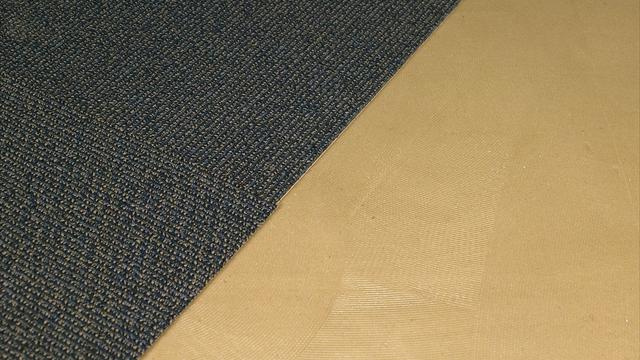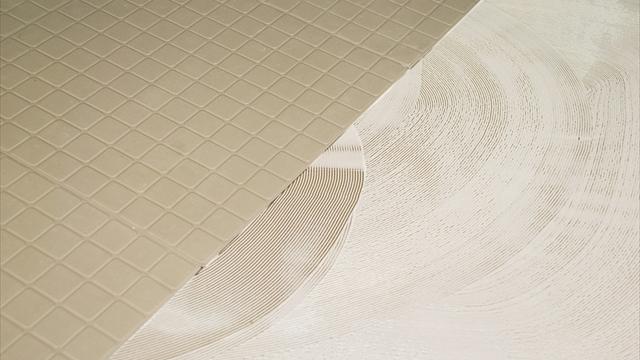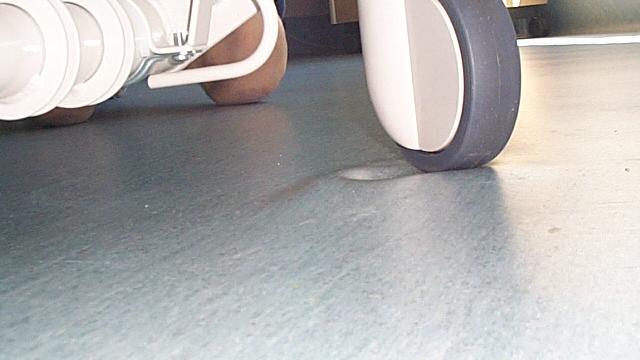
Sometimes it seems like the jargon used in the flooring industry deserves its own dictionary. Pressure-sensitive, full-spread, wet-set and hard-set are some examples.
Read on and we will explore the terms used in the flooring industry to describe adhesive. From this, you will be well equipped to understand words used in technical literature that are repeatedly misunderstood.
Adhesive is very easy to get carried away with, having many variants and different names for each type, or different names depending on the application. Regardless of all this, adhesive is just a substance that bonds a floor-covering product to a substrate. What else do we typically deal with when it comes to adhesive? What about language that specifies flash/waiting time, working time and how to apply adhesive to the substrate?

First, let’s look at the instruction to apply adhesive to a whole floor, or just part of it instead. Tell a person that a floor covering is a glue-down product, and their first assumption might be to do a full-spread application. As one might assume, this means that adhesive is spread over the entire substrate before flooring is laid onto it. This is a very common adhesive application method for carpet, linoleum, vinyl sheet products, fiberglass vinyl sheet products, modular luxury vinyl and more. However, it isn’t the only method known to man!
Some flooring manufacturers have products that specify use of the perimeter spread method. This is where adhesive is only spread around the outside edges of an area, and it can include instructions to adhere problem-prone areas like seams. This method is geared to application of certain types of sheet vinyl, luxury vinyl and similar products, but it should only be done when the flooring manufacturer recommends it.
The other method you might read or hear about about is called loose lay (or modified loose lay). Loose laying will generally not involve application of any adhesive at all, while a recommendation of the modified loose lay method would detail instructions for two-sided tape or adhesive being applied in strategic locations. I definitely recommend that you consider the owner’s intended use of the installed floor, and consult the flooring manufacturer when considering the loose lay method(s). The technique is beneficial for going over substrates that cannot be reliably bonded to, but it has its limits for traffic and use.

Next, let’s have a look at the characteristics of adhesives that distinguish them from one another. Regardless of the spread method chosen, an adhesive will have different installation and performance features that are based on its formulation and handling by the installer. Pressure-sensitive, wet-set, releasable, permanent bond and FastTrack Ready™ are probably terms that you’ve heard before. Interestingly, an adhesive can have one or more of these characteristics at the same time. Pressure-sensitive adhesives (PSAs), for starters, will permit bonding to material placed onto it with some amount of pressure. These adhesives will have the added step of flash time (or waiting time) to let the adhesive lose moisture and develop tackiness. We can experience this by pressing a finger on such an adhesive that’s been applied to a floor. Press lightly, and the sticky film will try to hold your finger in place. Press on it harder, and a PSA will hold permanently. Take the example of a sheet vinyl and PSA installation; adhesive that is spread on the surface will have some grabbing power as you lay flooring into it, following up by passing a weighted roller over the flooring to ensure that the bond is made.
Wet-set adhesives are quite different from PSAs, in that you lay flooring into the adhesive without delay. Wet set adhesives might involve an extremely short flash time for less porous surfaces, or no flash time at all. The wet-set adhesive’s bond is formed over time as the adhesive film cures and dries. MAPEI’s wet-set adhesives can be two-part products like Ultrabond G21, for example. There are also single-component wet-set products that don’t require the mixing of parts, such as
MAPEI’s Ultrabond ECO 360.
With a wet-set adhesive, the flooring is rolled to achieve 100% adhesive contact (also called transfer) between both the substrate and floor covering. Wet-set adhesives cannot remain open too long nor be allowed to dry in open air, because this will not permit adequate adhesive transfer. Care must be taken with a wet-set adhesive to avoid over-applying (causing puddles) or creating point loads like knee and foot impressions until the adhesive is ready for traffic. Boards can be placed loosely over the flooring to protect the adhesive from being displaced, should stepping or crawling on it be required. It is best practice to work your way out of a room, thereby avoiding this potential hazard.

As one might expect, wet-set and pressure-sensitive characteristics differ enough that they are generally not features exhibited by a single product. There are exceptions, though, such as MAPEI’s Ultrabond ECO 360. With this adhesive, flooring can be laid while some wet transfer remains. In other cases, you may wait until the
Ultrabond ECO 360 develops a pressure-sensitive quality.
This depends mostly on the type of flooring being installed. This class of adhesive rests at the halfway point between wet-set and pressure-sensitive, or one might say that this type is a hybrid. Adhesives with these properties are sometimes called transitional-set, and their manufacturers instruct the installer to begin installing when the adhesive has reached a “wet and tacky”state.

Wet-set and transitional-set adhesives tend to perform better in demanding, high-traffic institutional and commercial projects. This is because they set to a very rigid state, so they are sometimes referred to as hard-set adhesives. Because hard-set adhesives perform better in cases of extreme use, wet-set and transitional-set adhesives remain available despite the extra attention required when using them.
Now whenever someone says “use a wet set” or “loose lay the floor”, you’ll already have an idea of what the installation involves. This is a good place to take a break from analyzing the types of adhesive that exist. In Part 2 of this blog, we will continue to explore other flooring adhesive distinctions. Features described will include releasable versus permanent bond, FastTrack Ready™ adhesives, flash time, open time and more!
Comments
Load more comments